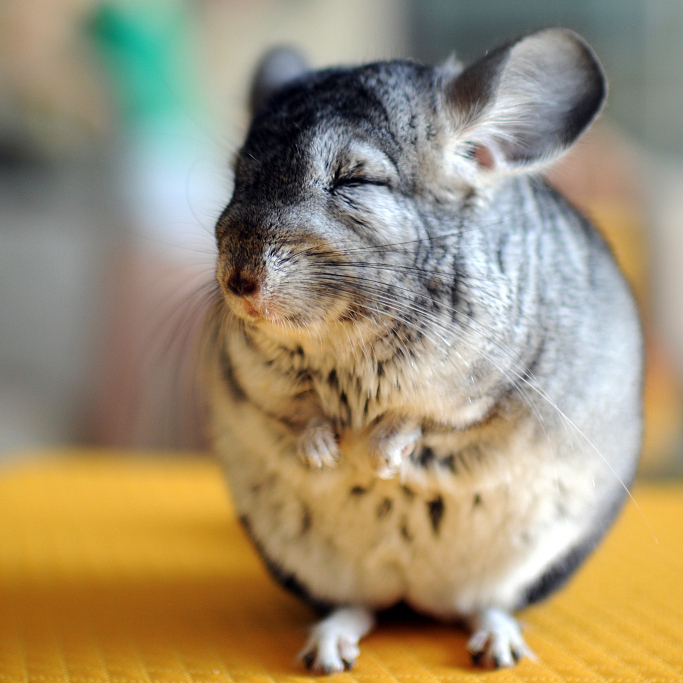Last Updated on July 2, 2021 by Fumipets
Chinchillas are tiny rodents that are native to South America and may be found in rocky, dry regions of the highlands. They are a kind of rat. The majority of chinchillas become domesticated and may form deep bonds with their owners when handled gently from a young age. However, don’t expect them to enjoy being handled and caressed in the same way that dogs and cats do. Although they are unlikely to do so, they will likely show their love for you in other ways.
When kept alone, chinchillas may be very content, and they will generally get along quite well in groups of the same sex, particularly if the two chinchillas are littermates or were brought to the household when they were young.

Behaviour and Temperament
Since chinchillas are mostly nocturnal, they will be most active at nighttime. They are often referred to as “crepuscular,” which means that their activity is at its height between the hours of dawn and dusk. However, they should be maintained in a somewhat calm environment during the day. They like a regular schedule for handling and feeding, and they may get upset if their habit is disrupted in any way. Chinchillas need a large cage to accommodate their high level of activity and playfulness. They also require regular exercise and playing. Chinchillas are more sensitive to warm temperatures than they are to cold ones, and owners should take measures to ensure that their pet chinchillas do not get overheated.
Chinchillas need careful handling and consistency in order to earn their confidence. Getting a new chinchilla accustomed to your hands and being handled may take a long time, particularly if the chinchilla is older and hasn’t been handled much in the past. Some chinchillas will never be comfortable being handled for long periods of time. They may prefer to be exploring rather than being confined, and they may prefer to climb on you rather of being restrained, but being able to handle and interact with your chinchilla will make your connection that much more enjoyable. A few basic techniques may help even the most fearful chinchilla get used to being handled. Maintain calm, moderate movement, and patience when training your chinchillas, and you’ll find that they ultimately react.
Housing
Chinchillas are probably most renowned for their extremely soft, thick, and luxuriant fur, which may be found in abundance. However, in the wild, this fur serves to shield the animals from the weather, but in captivity, it makes them more vulnerable to overheating. When choosing where to keep your chinchilla in the home, it is important to consider the following factors. A cage for your chinchilla should be kept in a cooler, more peaceful part of your house. In the summer, temperatures must be closely monitored to ensure that the ambient temperature does not rise much beyond 77 degrees Fahrenheit (25 degrees Celsius).
Chinchilla cages must be big, multileveled structures with platforms, ramps, and perches for the animals to live comfortably. The greater the size of the cage, the better. The minimum floor area required is about 24 by 24 inches, and a tall cage is preferred; if at all feasible, use one that has shelves and ladders to enable this mountain native to climb up and down. In general, wire cages are the best choice; avoid using plastic cages or accessories since chinchillas have a proclivity to gnaw through and damage plastic. Wood shavings, especially pine, may be used to line the tray; cedar and hardwood shavings, such as aspen, should be avoided, as should newspapers. However, although wire floors are convenient for keeping the cage clean, they may be difficult on the chinchilla’s feet, so it is better to avoid using them altogether. To give the chinchilla’s feet a rest, wire flooring or shelves may be coated with wood to provide a comfortable environment. A wooden nest box should also be supplied for the birds to nest in.

Diet and Nutrition
Chinchillas have particular food needs that are distinct from those of other rodents, which are listed below. They must be given a high-quality, chinchilla-specific diet if they are to maintain their good health. In order to thrive, chinchillas need a lot of roughage, and their diet should consist mostly of high-quality grass hay supplemented with pellets specifically designed for chinchillas. Treats should be given out in moderation at all times (no more than 1 teaspoon per day). Given that chinchillas have a delicate digestive tract, any dietary modifications should be done gradually.
Diets consisting of pellets are preferable to diets consisting of loose things. While commercially available loose mixes including chinchilla pellets, seeds, corn, and other food may seem to be nutritionally balanced while still in the bag, your chinchilla may not consume all of the components of the mix at the same time. As a result, individuals are more likely to select out and consume just the ingredients they like from a mixed meal, making it less nutritionally balanced overall. Instead of a loose mix, seek for a pelleted food that has been specially designed for chinchillas and has 16 to 20% protein, 2 to 5% fat, and a significant amount of fibre (15 to 35 percent).
Dust baths
Furry chinchillas, who are native to dry climates, need access to a dust bath on a regular basis. Maintain in mind that to keep your chinchilla’s silky, thick fur in excellent condition, it is necessary to give it frequent dust baths. Chinchillas should never be bathed in water, regardless of the temperature. Using fine chinchilla dust to create a dust bath allows you to get deep into the chinchilla’s fur, where it absorbs oils and clears away debris, without damaging it. Taking chinchilla dust baths not only helps to maintain their coats in tip-top condition, but they also seem to love the experience of taking a good, vigorous dust bath.
Toys
Chinchillas like chewing, running and jumping, and hiding in places. In order to keep your chinchillas entertained and active, you’ll need to provide them with a range of toys, particularly chewing things that will help to maintain their incisor teeth in excellent shape. Chew toys made of wood blocks and tree branches that have not been treated with chemicals are ideal for dogs. The willow balls and rings that you can buy for rabbits are also excellent toys for them, as are some of the wooden parrot toys that you can find. It is critical to offer toys that are free of tiny or plastic components that may be swallowed by young children. It is also possible to give a “chinchilla block” or a pumice block to be used for chewing, which will help in keeping the teeth tidy.
Running on a wheel may be a great source of exercise for your chinchilla, but you may discover that if you don’t expose it to the concept at a young age, it may not take to the notion. Try to choose a 15-inch wheel (anything less than that will be too tiny for most adult chinchillas), with a firm running surface on one side and an open side on the other with no cross supports, such as those found in wire wheels, which may be hazardous to the chinchillas’ feet and tails. Since plastic run-about balls offer a danger of overheating, it is preferable to keep your chinchilla inside, where it may run about safely and without encountering any exposed electrical wires or plastic to gnaw on.

Common Health Issues
Chinchillas are susceptible to the same health issues as other tiny animals, including rabies. They may develop respiratory or digestive issues, which manifest themselves as symptoms such as discharge from the eyes and nose, as well as diarrhoea and vomiting. Symptoms of illness in chinchillas include weight loss, hunching of the body, lack of grooming of the coat, trouble breathing, and feeding cessation.
Chinchillas may be harmed in addition to contracting infectious illnesses. Walking or running may be difficult if you have sores or broken nails on your feet. It is common for chinchillas to have enlarged teeth, which may be a nuisance.
A chinchilla that shows symptoms of sickness should be sent to an exotic vet for treatment. Meanwhile, avoid handling your chinchilla excessively since handling may be unpleasant for the animal.

Acquiring Your Chinchilla
Chinchillas are available for purchase from pet shops and breeders alike. It’s important to remember when purchasing a chinchilla that they are most active at night, so you may not see them at their most active during the day. Here are a few things to keep in mind:
Purchasing a baby chinchilla that is less than three months old is not a good idea since they are too young to be removed from their mother. As an alternative, attempt to locate an adult chinchilla that is around 4 months old, which is an excellent age at which to begin training your new companion.
It is possible to adopt a chinchilla that has been discarded; these animals will be older, but they will likely have previously been socialised.
Make certain that the chinchilla you’re contemplating is active and bright-eyed, has a healthy appetite, has lots of energy, and has a glossy coat.
If at all feasible, buy your chinchilla from a store or breeder that will be willing to assist you if you have any queries or have any difficulties.
Chinchillas, both male and female, have temperaments and lifespans that are quite similar to one another.


















